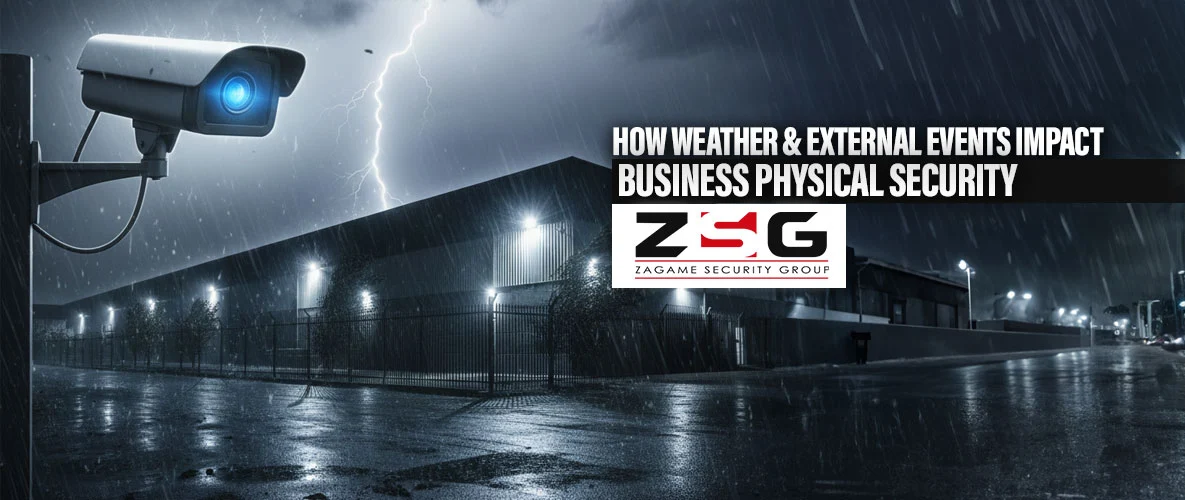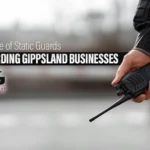When we think about business physical security, many of us picture locks, cameras, guards and alarms. But there’s another dimension that often gets undervalued: the impact of weather, natural events and external disruptions on your security systems and operational continuity. At Zagame Security Group, we see firsthand how storms, power outages, floods, wind damage or infrastructure failure create security vulnerabilities for business sites. In this blog we’ll explore how weather/external events affect physical security, how businesses can prepare and how effective monitoring and response make the difference.
The connection between weather & security
Weather-related events and external disruptions can affect physical security in several ways:
- Power failures: When power is cut off (storms, grid failure, substation issues) alarms, access control systems, CCTV and lighting may fail or operate only on backup power.
- Communication loss: If phone lines, internet or mobile networks go down, alarm signals may not reach monitoring centres or guards may be unable to call in.
- Flood or water ingress: Business premises in flood-prone areas may have access routes cut off, doors/windows compromised, or would-be intruders exploiting shuttered periods.
- Wind, fire or storm damage: External security infrastructure (fences, gates, cameras, lighting poles) may be damaged, creating new access points or blind spots.
- Business interruption: A site might be momentarily unattended because of an evacuation, structural damage, or delayed restaffing — this creates a window of vulnerability.
- Increased crime post-event: Following a major weather or event disruption, opportunistic crime tends to increase (e.g., theft from storm-damaged properties, looting when sites are unattended).
Why many businesses are unprepared
In our experience at Zagame Security Group, some of the common shortcomings include:
- Relying on legacy phone-line alarm signalling rather than resilient wireless or cellular monitoring.
- No backup power (UPS or generator) for CCTV, alarms, gates and lighting.
- No rapid-response patrol or guard mobilisation for after-hours or emergency access.
- Security protocols that assume “normal business hours” rather than variable conditions (eg. post-storm).
- Lack of coordination between facilities team (maintenance), security provider and business continuity plan.
Best practices for weather-resilient physical security
Here are strategies your business can implement:
- Upgrade alarm signalling to wireless/cellular with backup
As storms, floods and power outages increase the risk of communication loss, moving your alarm signalling from old phone lines (PSTN) to wireless or cellular, combined with backup power, ensures the monitoring centre remains in touch. - Ensure uninterruptible power (UPS) or generator backup for key systems
CCTV cameras, lighting, access control systems and alarm panels should be on backup power so they continue to function during an outage. This maintains deterrence and response capability. - Install sensors and monitoring for environmental risks
Consider flood sensors, ingress sensors (doors/windows), wind or structural-movement sensors, depending on the geographic risk. These tie into your security provider’s monitoring platform to alert pre-emptively. - Have a rapid-response mobile patrol or on-call guard team
When an event (storm, flood, evacuation) occurs, a business site that is temporarily unattended becomes vulnerable. Having a rapid-response security patrol or guard ensures that someone is physically onsite to inspect and secure the facility immediately. At Zagame we include mobile patrols as part of many commercial contracts. Zagame Security - Integrate into your business continuity and emergency plans
Security services need to connect to your overall business continuity plan (BCP). If you evacuate staff, redirect operations, shut down sections of the site or shift to remote work, your security provider must know and adjust coverage accordingly. - Carry out frequent post-event inspections and reviews
After a major weather event, conduct a full security walk-through: external perimeter, lighting, gates, CCTV brackets, cables, alarm panels, access control points and any structural damage. Document findings and remedy quickly.
Case study (hypothetical)
Suppose a manufacturing facility in Melbourne’s outer suburbs experiences a severe storm overnight: power is lost, phone lines are down, equipment is idle, loading dock staff couldn’t attend. In this vulnerable state, an intruder scales a fence in a dark zone (lighting failed), accesses the rear of the building, and steals equipment. While CCTV records the incident, the system was offline due to no backup power and the alarm signalling was lost due to phone-line failure. The delay in detection means higher losses, insurance complications and reputational damage.
Had the business implemented the above strategies — wireless signalling, backup power, mobile patrols after hours and ambient lighting backup — the likelihood of theft would have been significantly reduced.
Why Zagame Security Group is your partner for resilient security
- We provide alarm monitoring solutions including wireless fail-safe signalling to ensure your security system stays connected even during outages.
- Our mobile patrol teams are trained to respond to after-hours emergencies, weather-related risks and post-event inspection.
- We collaborate with businesses to embed security into their business continuity and emergency response plans — not just as an add-on.
Action plan for your business
Next 30 days:
- Review your current alarm signalling method — is it phone-line? If yes, ask your provider about wireless alternatives.
- Check your backup power provision for CCTV, alarms and lighting — how long will it run in a blackout?
- Walk your site after dark and after hours, preferably simulating poor weather (or after an actual weather event) and look for vulnerabilities.
Next 60 days:
- Engage your security provider to install environmental sensors (flood, ingress, wind) if your location is exposed to such threats.
- Arrange for a post-event “after storm” mobile patrol and inspection.
- Update your site’s security plan to include business continuity triggers (power loss, weather alert, evacuation) and inform your security partner.
Next 90 days:
- Run a full drill: simulate power outage or access disruption, test your backup systems, test alarm signalling, test guard/patrol response.
- Review incident history or near misses from weather or external events and update your risk map.
- Communicate to staff about security protocols during business interruption.
Weather and external events are not always predictable — but their impact on your business physical security is real. By anticipating failures (power, communication, lighting) and preparing your site accordingly, you can dramatically reduce your vulnerability. If you’d like to discuss how Zagame Security Group can help you build a resilient, business-ready physical security system, please get in touch.





